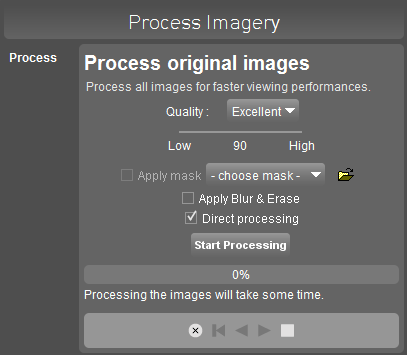Process MM Imagery

This page describes how to use the desktop mobile mapping administrator procedures “Process Imagery”1) and the advantages of processed images.
The “Process Imagery” procedures optimizes original mobile mapping images of the opened Orbit run into processed images, stored as Orbit native Orbit multi-resolution images.
![]()
- Procedures > Administration > Mobile Mapping > Process Imagery
Processing imagery is optional. It will improve performance and is strongly advised for web publishing.
How to use
Quality
Set the jpg quality of the processed images.
Select one of the preset values or use “Custom” to set any quality value via the slier below.
Higher quality will increase the file size and the corresponding time to load the image.
There is no point to process the images with a higher quality than the original image files. For most use cases quality 80 “Good” is ok.
More information about the effect of jpg quality and compression : https://en.wikipedia.org/wiki/JPEG.
Mask
Set the mask file to hide unwanted structures (e.g. GPS antenna, car roof top, …).
Optionally select or add a mask to be applied on top of the processed images.
A mask is a *.png file having exactly the same resolution as the original images. Its color and transparency are taken into account while processing.
Blur & Erase
Set option to apply blurred and erased registered areas.
Optionally activate blurring to be applied on top of the processed images.
Blur and erase areas can be registered using the Orbit extension Blur and Erase extension, see www.orbitgt.com/content/mobile-mapping.
Process
Start image processing or add this job to the task manager (turn off “Direct processing” and “Save Import”).
All images of the currently opened run will be processed.
This process can be stopped at all time. The processing of ongoing images will be completed, already processed images are retained.
The job can be restarted at all time, already processed images will be skipped. To process images again the according processed images should be removed from the <Orbit run>/<camera>/processed sub folder, more information about the image run structure see Orbit Run Versions & Structure.
Processing images is multi-threaded and will use all available cpu and memory resources. This will slow down your computer's performance. The advise is to do this over night.
Advantages of Processed Images
CPU for Publishing
Original images (jpg, tiff, png, … ) require much more CPU to be loaded and displayed both for Publisher and Web client. This results in higher server requirements to avoid server performance issues.
Processed images do not require some of the time and CPU consuming processes.
Also for an Orbit desktop, processing the images will reduce the time required to display the image.
Data streaming
Original images must be loaded completely in full resolution before they can be displayed by a client.
Processed images are loaded in an intelligent, more efficient way which reduces strongly the volume of data (and according time) to be transferred.
Also for an Orbit desktop, processing the images will reduce the data transfer.
Low resolution preview
Original images must be loaded with a single full resolution request to be displayed.
Processed images include a low resolution image for instant response on client side.
Processing Time
Some stats and facts of processing images
Example image processing 123,787 images/ 59 hours 27 minutes, 2082 images/hour, 34.7 images/minute
- 64bit, Quad core, 16GB memory, Intel core i7
- read from external USB3 connected hard disk
- write to internal SSD drive
- original images : 8000×4000 pixels, jpg quality 80, average size of 4.25 MB/image,
- processed images : same resolution and quality, average size of 5.31 MB/image
Disk Storage
Processed images are stored in the “processed” sub-directory of the Orbit run :
- <Orbit Run directory>\panorama1\processed\
- <Orbit Run directory>\planar1\processed\
Processed images are not optimized for disk storage but for viewing performance. Depending the image compression of the original images the size of the processed image will vary between the original size (uncompressed original images) and twice the original size (strong compressed original images).
Ensure the required disk-space is available.